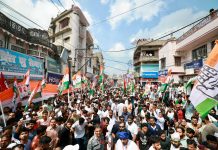
A week, former British Prime Minister Harold Wilson once said, is a long time in politics. For the Aam Aadmi Party (AAP), that would be the third week since it sensationally took power in Delhi at the year-end. And it has indeed been painfully long. For the first time since they formed their ingeniously named political outfit in 2012, a difference of opinion is rewriting relationships among its top leaders. On one side is a close confidant of party chief (officially “convener”), Delhi Chief Minister Arvind Kejriwal, who took the unusual step this week of calling an impromptu public sit-in barely a hundred metres from Parliament, triggering fears of a violent showdown with the constabulary mandated to clear out the area ahead of the 26 January Republic Day celebrations. On the other side is a clutch of other leaders trying to be a counterweight; who want the high-velocity rollercoaster to stop being an anarchic free-for-all and instead bring order to the ranks.
For the moment, though, Delhi’s Public Works Minister Manish Sisodia, a soft-spoken man considered to be closest to Kejriwal, has the aces. His hold over Kejriwal is a legend within the party. Even Supreme Court lawyer Prashant Bhushan and pollster-scholar-turned-politician Yogendra Yadav, both top party leaders themselves, are fighting for space vis-à-vis Sisodia. Inevitably, as is inherent in power politics, the two factions are shadow-boxing with each other, where both Yadav and Bhushan are working hard to retain their prominence in the party even as Sisodia has increased his profile massively, especially since becoming a minister on 28 December.
The differences between the two sides have sharpened following the antics — past and present — of two of the party’s prominent public faces. Delhi’s Law Minister Somnath Bharti’s so-called citizens’ initiative against an alleged drug-and-prostitution racket run by African nationals in south Delhi boomeranged badly after at least one woman ambushed at her home bluntly accused AAP vigilantes of criminal assault. The second incident that has sharpened the fault lines is the emergence of a five-year-old video recording of a stand-up comedy routine by Sisodia’s childhood chum, Kumar Vishwas, who has worked closely with Kejriwal ever since the latter launched his anti-corruption public movement at New Delhi in 2011.
In the video Vishwas is heard calling female nurses from Kerala “black and yellow” in Hindi, in an uncharitable and unfair reference to their complexion. A few days earlier, another comic gig from years ago surfaced wherein Vishwas had made a Muslim religious event the butt of a joke. As the AAP office was attacked in Kerala following the emergence of the comment on Malayalee nurses, Sisodia swung into motion to save Vishwas. At stake is Vishwas’ desire to take on Congress vice-president Rahul Gandhi from Amethi’s Lok Sabha constituency. Vishwas has in fact been pushing unilaterally to be the party’s candidate there. A section of the party has been miffed with Vishwas as many believe that he is pushing his own agenda in violation of the party’s stated principle that it is a party with a difference — one that rejects individual political ambitions.
As Vishwas himself swung into action appearing on television news defending his comedy, Sisodia lobbied Kejriwal insisting that the party stand solidly behind Vishwas as he was being unfairly targeted. This was on the same day that Kejriwal called off his two-day sit-in near the railway ministry headquarters, where thousands had gathered backing the party’s demand for suspension of the policemen who had refused to follow the bidding of Law Minister Somnath Bharti to file criminal cases against the African women Bharti and cohorts had set upon on 15 January.
Indeed, the entire drama that began with Bharti’s “raid” and ended with a tame and abrupt withdrawal of the sit-in on 21 January has left many in the party’s leadership upset for being forced to support Bharti and bluster their way through the crisis. These include the party’s several spokespersons, including the newly inducted journalist-turned-politician Ashutosh who privately complained that he felt embarrassed defending Bharti’s actions that were clearly indefensible and served to undermine the party’s pro-women credentials.
What is troubling several senior leaders is that Kejriwal and Sisodia are both convinced of the correctness of Bharti’s action. They are equally certain that, even if the chattering classes attack the sit-in as a constitutional impropriety, the bulk of Delhi’s citizenry will back them for taking on the high-handed behaviour of the police.
This intransigence of Kejriwal and Sisodia has made a section of the party uneasy, notably the middle classes who place great store in constitutionality and political correctness. The two leaders’ dismissive attitude towards those who call for restraint, especially since they are now in the government, has alienated not a few in the party’s higher echelons, especially those who align with the progressive civil society elements. (They point out to a strongly worded letter of disapproval that a clutch of feminists, many of whom had otherwise supported the AAP and contributed to building its political profile, wrote to Kejriwal demanding an apology from Bharti for his act.)
A notable absentee from the Delhi sit-in was Shazia Ilmi, the party’s most visible female face, not least for her forceful presence on television, until she lost the 4 December Assembly election by a tiny margin. Her stature in the party as a leading female politician has been overshadowed by the emergence of 26-year-old Rakhi Birla, who won the election and was made the Women and Child Development Minister. Ilmi has also been effectively pegged lower in a reorganisation wherein her name was not included in the list of party’s official spokespersons issued this week, which however included Ashutosh just days after he joined the party after quitting his job as a news anchor.
Despite their continued misgivings about Vishwas and Sisodia, both Yadav and Bhushan are, for the moment, wary of pushing for Vishwas to be sidelined. One line of thinking is that they may well wait until Vishwas trips up yet again in the next few months, and which would eventually seal the case against him. Yadav, in fact, has been feeling stretched thin by a constant need for his presence in Delhi when he wants to devote himself exclusively to the neighbouring state of Haryana, for the upcoming Lok Sabha election as well as the Assembly elections due in October.
Indeed, the scramble to get a ticket for the Lok Sabha has already gripped the party’s key 50-odd leaders, who are all angling to contest from constituencies where the party will have a strong chance to win. But thousands have literally begun to mob its offices across India to seek tickets for the Lok Sabha election, buoyed by the dreamy emergence of yesterday’s commoners as today’s ministers and MLAs in Delhi. The list of hopefuls includes a number of prominent citizens who have recently jumped on the AAP bandwagon inspired by its spectacular electoral success in Delhi.
And trouble may yet emerge for Kejriwal from some of the new high-profile entrants to the party, most notable of whom are former aviation entrepreneur GR Gopinath and Gujarat’s leading activist and noted danseuse, Mallika Sarabhai. Sarabhai slammed Vishwas last week for his comic routine against the Muslim event. And Gopinath demanded this week that Bharti be sacked. All this makes for a lot of internal churning. In short, the Aam Aadmi Party has arrived in the world of politics.
ajit@tehelka.com












